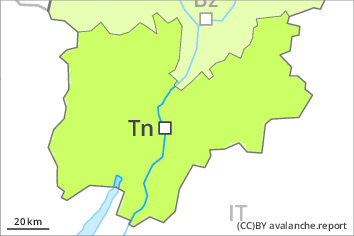
Danger level
 |

Low avalanche danger will be encountered over a wide area.
The fresh wind slabs can in very isolated cases be released, even by a single winter sport participant, especially on very steep shady slopes above approximately 2400 m. These avalanche prone locations are to be found in particular in gullies and bowls, and behind abrupt changes in the terrain. In very isolated cases dry avalanches can also be released in the old snowpack. Avalanche prone locations are to be found in particular in little used terrain above approximately 2400 m, especially on very steep shady slopes. Mostly avalanches are small.
As the temperature drops only isolated wet and gliding avalanches are possible. This applies especially in case of releases originating from extremely steep, sunny starting zones below approximately 2400 m that still retain some snow.
Snowpack
dp.6: cold, loose snow and wind
Some snow will fall in some localities. As a consequence of a moderate to strong northwesterly wind, clearly visible wind slabs will form in the course of the day.
A partly overcast night. The surface of the snowpack will only just freeze and will soften during the day, especially at intermediate altitudes. The high temperatures gave rise to increasing and thorough wetting of the snowpack over a wide area below approximately 2400 m.
The snowpack remains subject to considerable local variations. Within the snowpack, there are multiple melt-freeze crusts sandwiches with faceted layers in between, in particular on steep sunny slopes in all altitude zones, as well as on shady slopes below approximately 2600 m.
At low and intermediate altitudes only a little snow is lying.
Tendency
Currently there are quite favourable conditions generally. Low avalanche danger will be encountered over a wide area.